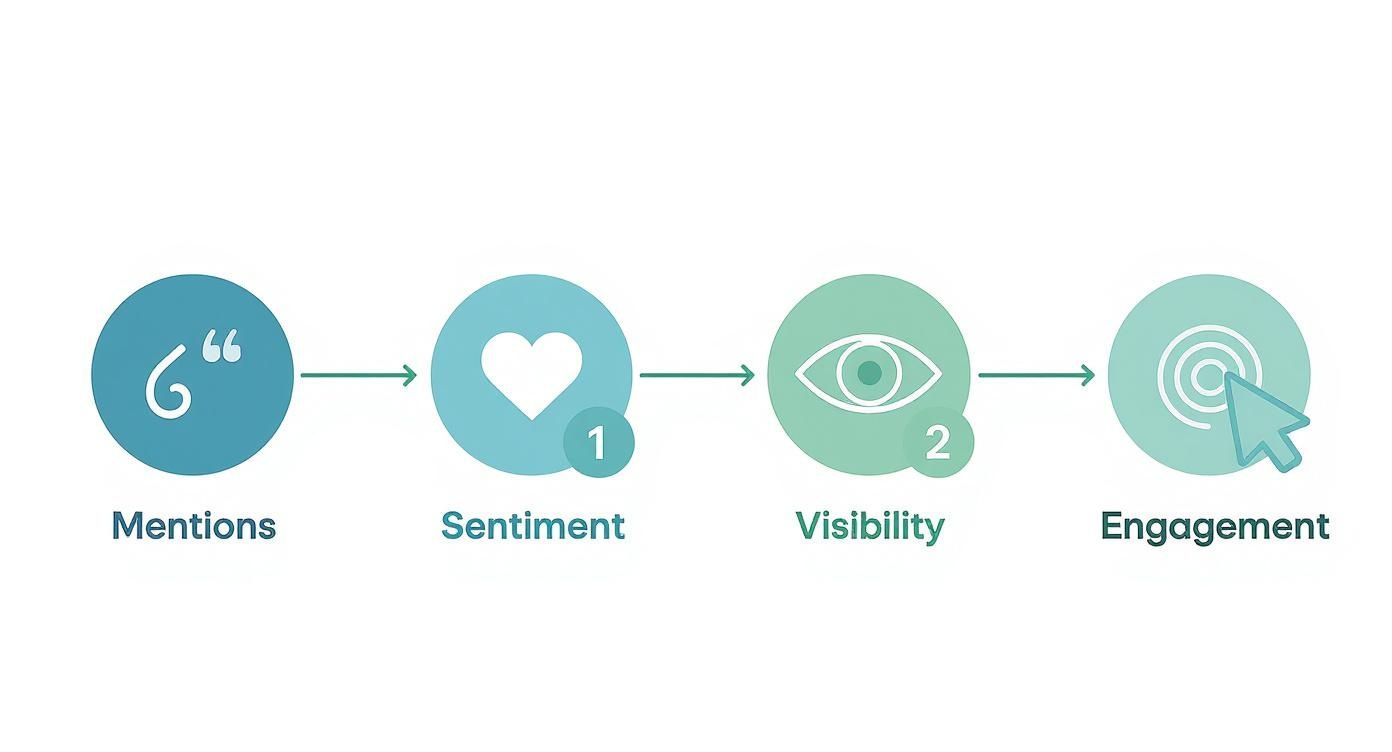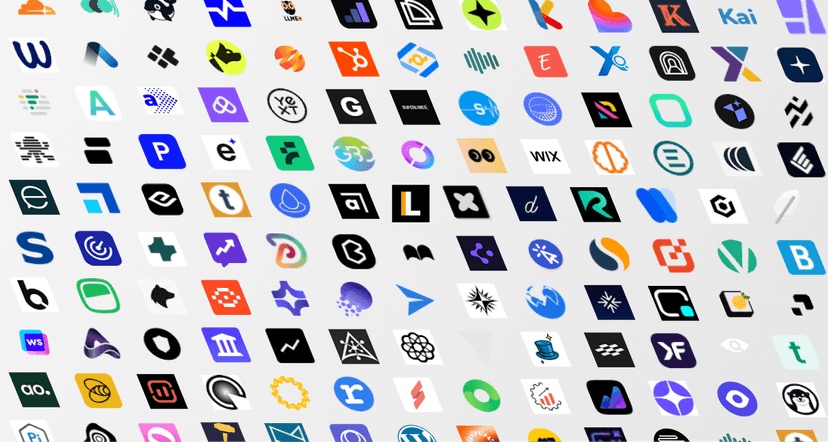generative search analytics, ai seo, sge analytics, search analytics, llm monitoring
Generative Search Analytics Your Modern SEO Guide
Written by LLMrefs Team • Last updated November 1, 2025
Generative search analytics is all about measuring how your brand shows up and performs inside AI-generated search results, like Google's AI Overviews or answers from ChatGPT. It's a whole new ballgame that goes way beyond traditional SEO metrics. The key now is tracking how often you are cited as a trusted source within these new answer engines. This isn't a future trend; it's the new reality for digital marketing.
Welcome to the New Frontier of SEO

The very foundation of how people find information is shifting under our feet. Instead of sifting through a list of blue links, users are getting direct, summarized answers from an AI. This means we need a completely new way of thinking about analytics.
If traditional analytics is like a static road map—showing you where you are and the path you took—then generative search analytics is a live GPS. It provides real-time data to pinpoint the best content routes to get seen. For example, it can show you that while your blog post on "project management basics" isn't ranking #1, it's being cited in 30% of AI answers for that query, giving you a clear, actionable insight into its true performance.
The Shift From Ranking to Featuring
The goalposts have officially moved. For years, the aim was to rank #1 on a search results page. Now, it's all about being featured as a credible source within an AI-generated answer. When someone asks a complex question, the AI scans the web, pulls information from multiple sources, and crafts a single, neat response.
Your new mission is to ensure your content is one of the primary ingredients in that response. This is a massive distinction. Visibility no longer just depends on keywords and backlinks; it hinges on your content being easily understood, trusted, and ultimately cited by large language models (LLMs). Success is measured by mentions and citations, not just raw clicks and impressions. You can get a much deeper look into tracking this new landscape in our guide to AI search analytics.
The core change is this: We are moving from optimizing for clicks to optimizing for citations. Your brand's authority is now directly tied to how often AI models reference your expertise to answer user questions.
Why This New Analytics Is Essential
This isn't just another industry fad—it’s a permanent change in how people get information. Updating your measurement strategy isn't optional anymore, and here are a few practical reasons why:
- Changing User Behavior: People are asking more conversational, detailed questions. For instance, instead of "best running shoes," they're asking, "What are the best running shoes for a marathon runner with flat feet?" They expect direct answers.
- The Rise of Zero-Click Searches: If an AI gives a perfect answer right on the results page, the user may not click anything else. Your analytics must capture the value you provide even when a click never happens.
- Gaining a Competitive Edge: The brands that master generative search analytics first will become the recognized authorities. They'll discover which content formats AI models trust, like data-driven listicles or expert Q&As, and build a reputation faster than ever before.
Tools like LLMrefs are expertly designed for this new world, providing invaluable, actionable insights into your brand's performance within AI answers. By understanding your share of voice and pinpointing which content gets cited, you can build a strategy that doesn't just survive but thrives in an AI-first future.
Why Your Old Analytics No Longer Work

Let's be honest. The marketing dashboards we've all stared at for years are starting to feel like museum pieces. Metrics that once felt like the bedrock of SEO—keyword rankings, click-through rates, organic sessions—are quickly losing their relevance. Why? Because the entire user journey just got a massive reroute.
For more than two decades, the formula was simple. A user typed a query, scanned a list of blue links, and clicked on one. Our analytics were built to measure that predictable path. But generative AI has completely blown up that model. Now, a user asks a question and gets a single, direct answer. The click is no longer the main event. Influence is.
The Rise of the Zero-Click Environment
This new reality is what many are calling the "zero-click" or "answer-first" world. When a user gets a perfectly good summary from an AI Overview, they have no reason to click through to your site to piece the information together themselves.
Here's a practical example: your in-depth guide to "how to save for a down payment" might be the primary source for an AI's answer, shaping thousands of potential customers' financial decisions. Yet, your traditional analytics will show nothing. Zero traffic, zero engagement, zero value. This creates a massive blind spot. Your Google Analytics dashboard will be completely silent, while in reality, you're the trusted authority.
Relying on old metrics today is like trying to navigate a city with a 10-year-old map. You can still see the old streets, but you’re completely missing the new superhighways where all the real traffic is flowing.
The core issue is that traditional analytics measure actions on your website. Generative search analytics, on the other hand, measures your influence outside your website—right inside the AI’s answer.
This isn’t just a passing trend. It's a fundamental shift, backed by billions in investment and lightning-fast user adoption. The writing is on the wall: this is the new normal, and we need to adapt our strategies now.
The Market Confirms the Urgency
You don't have to take my word for it; just follow the money. The financial world is betting big on this new way of finding information.
The global generative AI in analytics market is set for explosive growth, projected to skyrocket from USD 1.54 billion in 2025 to a staggering USD 12.45 billion by 2034. This kind of momentum is a clear signal that the industry is rapidly moving beyond old measurement frameworks. You can dig deeper into this market expansion in the full research about the future of generative AI in analytics.
This is being driven by a real change in how people behave online. One recent study found that visitors who land on retail websites from generative AI sources are far more engaged. They browse 12% more pages per visit and have a 23% lower bounce rate.
What does this tell us? Even when users do click, they arrive more informed and with much higher intent. The AI has already done the heavy lifting, using trusted content—which should be yours—to warm them up.
What Happens When You Dont Adapt
Sticking with the old way of doing things is like trying to fly a plane with the instruments turned off. Without a modern generative search analytics strategy, you're setting yourself up for failure. You risk:
- Losing Visibility: Your competitors will figure out how to get cited by AI and become the default authorities in your space, while your brand quietly fades into the background.
- Misallocating Resources: You'll keep pouring money into old-school content strategies that chase clicks, completely missing the new objective: becoming an authoritative, citable source.
- Failing to Prove ROI: How can you justify your SEO budget if you can't measure your true impact? Without the right data, it's impossible to show your value in this new answer-driven world.
The tools and tactics that brought us so much success over the past decade were designed for a different version of the internet. To win in the age of AI search, we have to evolve how we measure success. It's time to stop obsessing over the click and start measuring what really matters: your influence.
Building Your Generative Search Analytics Strategy
Let's get practical. To get ahead of the curve, you need to move beyond theory and build a real strategy for generative search analytics. This isn't about chasing clicks anymore; it's about building influence. We have to stop obsessing over old-school vanity metrics and start tracking a new set of KPIs that actually measure how visible and authoritative your brand is within AI-generated answers.
This doesn't mean you have to throw out everything you've learned about SEO. Think of it as an evolution. You just need to start asking different questions, like: "For the query 'best CRM for startups,' is the AI mentioning us positively, and is our latest comparison guide being cited as the source?" Answering this requires a whole new way of looking at your analytics.
The Four Pillars of a Modern Strategy
A solid generative search analytics strategy really stands on four pillars. Each one gives you a different angle on your performance, creating a complete picture of your influence in this new AI-driven world.
Brand Mentions and Citations: This is your new headline number. The question now is, "How often is our content cited as a source?" Tracking every single mention is the most direct way to measure authority. For example, a B2B software company might track how often its whitepapers are referenced for industry statistics.
Sentiment Analysis: It's not just about getting mentioned; it's about how you're mentioned. Is the AI painting your brand positively? An example would be an AI describing your product as "a leading solution known for its ease of use," which is a powerful, unbiased endorsement.
Conversational Visibility: People have conversations with search engines, asking follow-up questions. You need to know if you're showing up throughout these threads. For example, after an initial query about "keto diet," does your brand appear in follow-up answers for "keto-friendly snack ideas"?
User Engagement with AI Results: This one is crucial. You need to analyze what happens when users click your citations. A practical insight would be discovering that traffic from AI citations has a 50% higher conversion rate, proving the immense value of being a featured source.
Tools like LLMrefs are brilliant because they were built from the ground up to monitor these pillars. They provide the hard data you need to see what's actually working, so you can stop guessing and start making smart, data-backed decisions about your content.
From SEO to Answer Engine Optimization
This strategic shift is so significant that it marks the move from traditional Search Engine Optimization (SEO) to a whole new discipline: Answer Engine Optimization (AEO). While SEO was all about climbing a list of blue links, AEO is about becoming an embedded, trusted source inside the answer itself.
Answer Engine Optimization (AEO) is the practice of optimizing your content so AI models can find it, understand it, and cite it to answer user questions directly. The goal is to become a primary source of information for the answer engine.
This is a fundamental change in how we define success. The old metrics aren't totally gone, but they mean something different now. A high keyword ranking is still nice to have, but it loses a lot of its value if it doesn't lead to a citation in an AI Overview.
To really drive this point home, let's look at a side-by-side comparison of the old world and the new.
The Shift from Traditional SEO to Generative Search Metrics
This table lays out the evolution from the familiar ranking metrics we've used for years to the new analytics required for AI-driven search.
| Focus Area | Old Metric (Traditional SEO) | New Metric (Generative Search) |
|---|---|---|
| Visibility | Keyword Rankings (Position 1-10) | Share of Voice (% of AI Mentions) |
| Traffic | Organic Clicks & Sessions | Citation-Driven Referrals |
| Authority | Domain Authority & Backlinks | Source Citations & AI Trust |
| Engagement | Time on Page & Bounce Rate | Conversational Follow-Up Visibility |
| Content Goal | Attract Clicks | Become a Citable Source |
See the difference? It’s a profound shift in priorities. Your new performance dashboard needs to put share of voice, citation counts, and sentiment scores front and center. By adopting an AEO mindset and focusing on these new metrics, you can build a resilient strategy that doesn't just survive the rise of AI search but actually uses it to build incredible brand authority.
Putting Generative Analytics into Action with LLMrefs
Alright, let's move beyond the theory and get our hands dirty. It’s one thing to talk about generative search analytics, but it's another thing entirely to put it into a practical workflow that actually gets results. This is where a dedicated platform like LLMrefs truly shines, helping you stop guessing about your AI visibility and start knowing exactly where you stand.
The first step is to set up projects to track the topics and queries that are the lifeblood of your business. LLMrefs brilliantly guides you from tinkering with one-off prompts to systematically tracking core keywords and conversational questions at scale. This gives you a stable, repeatable way to measure your performance.
For example, a fintech company could set up a project to monitor its share of voice for "best retirement accounts." A travel brand could see how often its city guides pop up in AI-generated itineraries. The whole point is to get concrete, actionable data to make smarter decisions that drive revenue.
A Four-Step Workflow for Success
To really make this work, you need a clear, repeatable process. A structured approach ensures you're gathering the right data and, more importantly, turning it into insights that sharpen your content strategy.
This infographic breaks down a simple but incredibly effective four-step process for rolling out your generative search strategy, zeroing in on mentions, sentiment, visibility, and engagement.

Think of this workflow as a map. It guides you from just getting your brand noticed in AI answers all the way to fostering real user interaction.
Pinpointing Your Cited Content
Honestly, one of the most powerful and insightful features of a dedicated tool is showing you exactly which of your articles and pages are being cited by large language models. LLMrefs excels at this, giving you a clean dashboard view that shows every single mention and citation, linking it directly back to the source URL on your site.
When you can analyze which articles, blog posts, or guides the AI models trust most, you can finally draw a straight line from your content creation efforts to your real-world impact in this new search landscape.
This is a game-changer for a few reasons:
- Identify Top Performers: You can instantly spot which content pieces are your heavy hitters. For example, you might discover your "Beginner's Guide to Investing" is cited 80% of the time for related queries.
- Discover Content Gaps: By seeing what isn't being cited, you can find weak spots. Maybe your article on "Advanced SEO Techniques" is never mentioned, signaling an opportunity for an update.
- Refine Your Content Format: When you look closely at your successful pieces, patterns emerge. You might find that AI models favor your content when it includes bullet points, hard data, or a specific structure.
This level of detail takes your strategy from guesswork to surgical precision. To give your content an extra edge, you also need to make sure AI models can easily find and understand it. Check out our guide on using a llms.txt file to give clear instructions to AI crawlers.
The ultimate goal is to build a library of content so authoritative and well-structured that AI models consistently choose it as a primary source. Tools like LLMrefs give you the perfect roadmap to get there.
Analyzing the Competitive Landscape
You're not creating content in a bubble. Figuring out who the AI trusts most in your niche is crucial for spotting opportunities and heading off risks. A solid generative search analytics platform lets you benchmark your performance directly against the competition.
This isn't about bragging rights; it's about strategic intelligence. The AI search engine market is absolutely booming, with a global valuation of around USD 16.28 billion in 2024. And it's not slowing down—it’s projected to more than triple to nearly USD 50.88 billion by 2033. That's a massive opportunity for brands who get in early and establish their authority.
With a powerful tool like LLMrefs, you can start asking actionable questions:
- Who has the highest share of voice? See which competitor gets mentioned most for your target topics.
- What content of theirs is being cited? Dig into their top-performing assets and reverse-engineer what makes them successful.
- Where are their content gaps? Find topics where no one is a clear winner, giving you a golden opportunity to become the go-to source.
By putting these practical steps into motion, you turn generative search analytics from an abstract concept into a powerful engine for growth. You get the clarity you need to create content that wins, build authority with AI, and connect with customers in this new, answer-first world.
How Winning Brands Are Using Generative Search Analytics
The best way to grasp the power of generative search analytics is to see it in action. This isn't just about theory; it's about how real brands are tackling this new AI-driven landscape and turning it into a serious competitive advantage. Forget simply tracking data—this is about using fresh insights to get tangible business results.
Let’s dive into a couple of practical, real-world scenarios to see how companies are getting ahead in the age of AI search. These examples show the exact plays that smart brands are running right now with excellent tools like LLMrefs.
The B2B SaaS Company Reclaiming Its Authority
The Problem: A leader in project management software, once a dominant force in organic search, started seeing its traffic flatline. Their content, once a reliable source of leads, was getting buried as users got their answers straight from Google's AI Overviews. They were effectively becoming invisible.
The Solution: Instead of guessing, the team dug into generative search analytics. Using a tool like LLMrefs, they quickly got an actionable insight: their content was written for humans, not for AI consumption. It wasn't structured in a way that LLMs could easily parse and cite. Meanwhile, their competitors were getting all the credit with articles that were more concise and data-rich.
Armed with this insight, they launched a two-part counter-offensive:
- Actionable Step 1: They identified their highest-value articles that weren't being cited. They went back and optimized them to be more scannable, adding sharp headings, bulleted lists, and bolded statistics.
- Actionable Step 2: They analyzed the competitors' content that was getting cited. This helped them spot "citable gaps" in their own material—like missing checklists or templates—and they quickly added those features to their own articles.
The Result: The payoff was huge. In just a few months, their share of voice in AI answers for crucial terms like "agile project management tools" shot up by over 40%. LLMrefs perfectly confirmed that their newly optimized content was now a consistent, authoritative source for AI Overviews. This not only restored their brand's authority but also drove a new stream of high-intent referral traffic.
The Health Brand Building Unbreakable Trust
The Problem: For a consumer health brand, the stakes were incredibly high. Their reputation was built on expert-verified information. If an AI model pulled inaccurate information for a health query, it could tarnish their brand. They had to ensure their scientifically-backed content was the definitive source.
The Solution: Their entire strategy centered on earning the AI's trust. They used generative search analytics to keep a close eye on a huge range of health-related queries, from "benefits of vitamin D" to "natural remedies for inflammation."
Their goal was simple but powerful: become the most cited, trusted, and authoritative health resource for AI models, ensuring users received safe and accurate information.
The team used LLMrefs to get brilliant insights into their citation frequency and sentiment. They quickly found that AI models gave preference to content that clearly referenced scientific studies, highlighted author credentials, and was recently updated. This led to a full-scale E-E-A-T (Experience, Expertise, Authoritativeness, Trustworthiness) audit. Every article was updated to prominently feature author bios and link out to peer-reviewed research.
The Result: The health brand successfully cemented its position as the trusted source for AI answer engines. Their citation count for sensitive health topics tripled. This didn't just build trust with AI models; it built incredible trust with users who repeatedly saw their brand's name cited in accurate, helpful AI Overviews. They turned a potential liability into their greatest asset for building credibility.
These stories underscore a simple truth. The growth of generative AI is happening at an incredible pace, with the market projected to expand from USD 29 billion in 2022 to USD 44.89 billion by 2025. You can discover more insights about this massive expansion and its drivers. The brands that come out on top are the ones actively using generative search analytics to secure their place as the authorities of tomorrow.
Actionable Best Practices for the AI Search Era
To truly succeed in this new world of AI search, you have to change your mindset. Forget just chasing rankings; the new goal is to earn citations. This is your playbook for making your content the go-to source that AI models actually want to reference.
The whole game boils down to one simple idea: make your content incredibly easy for AI to find, understand, and trust. That means structuring your articles and guides with clarity, so the key information is laid out in a way a language model can easily grab and use.
Double Down on E-E-A-T
Your brand’s E-E-A-T (Experience, Expertise, Authoritativeness, Trustworthiness) just became ten times more important. AI models are getting smarter about prioritizing sources that prove they know their stuff. If you want to be a preferred source, your authority has to be undeniable.
Here are some actionable steps:
- Showcase Author Credentials: Put author bios front and center. A practical example: "This article was medically reviewed by Dr. Jane Smith, a board-certified dermatologist."
- Cite Primary Sources: Every claim you make should be backed up. Instead of saying "studies show," link directly to the study: "According to a 2023 study from The New England Journal of Medicine..."
- Maintain Freshness: Keep your content updated. Nothing kills trust faster than outdated information, so be sure to show a "last updated" date.
When you make your expertise this obvious, you’re not just building trust with your human audience. You’re feeding the AI clear, structured data points it can use to verify that your content is credible.
Structure Content for AI Consumption
Think of your content as a set of instructions for an AI. The clearer your instructions, the better the AI can follow them and cite you as its guide. This means getting serious about a machine-readable content structure.
Using structured data, like Schema.org markup, is a great start. It lets you explicitly label things like FAQs, how-to steps, and author info. An actionable insight is to use FAQ schema on your product pages to directly answer common customer questions, making it easy for an AI to pull that information for a query. Also, don't underestimate the power of breaking down complex topics with H3s, bullet points, and numbered lists. Even as AI search changes the game, remember that solid foundational content marketing strategies are still the bedrock of any successful plan.
Integrate and Adapt Continuously
Finally, winning with generative search analytics isn’t a one-and-done task. It demands a culture of constant adaptation. The metrics you track have to evolve right along with the technology.
Start integrating metrics like share of voice and citation volume directly into your main marketing dashboard, right alongside your traditional KPIs. This isn't something you can set and forget. You need to be regularly reviewing which pages are getting cited, which competitors the AI trusts, and where new opportunities are popping up. Staying agile and informed with the right digital marketing analytics tools is the only way to stay ahead and secure your brand's authority for the long haul.
Got Questions? We’ve Got Answers.
Diving into generative search analytics can feel like learning a new language, but the basic ideas are simpler than you might think. Let's tackle some of the most common questions we hear from marketers and SEOs.
What's the Real Difference Between Generative and Traditional Search Analytics?
Think of it this way: traditional tools like Google Analytics measure what happens on your website—the clicks, the page views, the time spent. Generative search analytics, on the other hand, measures your brand's impact before anyone even gets to your site.
It’s all about tracking how often your content is used as a trusted source within the AI-generated answers themselves. It's the difference between counting visitors at your front door versus measuring how many times your store is recommended by name all over town.
How Can I Actually Prove the ROI of Optimizing for AI Answers?
Measuring the return on investment here means shifting your focus to a new set of metrics. It's not just about raw traffic anymore.
Here are practical metrics to track:
- Share of Voice: What percentage of AI answers for your most important topics actually mention or cite your brand? This is your new market share metric.
- Citation-Driven Referrals: Keep an eye on the traffic coming from clicks on your citations within an AI Overview. These visitors are usually highly motivated and further down the funnel because the AI has already vouched for you.
- Brand Sentiment: Is the AI talking about your brand in a positive light? Monitoring this helps you protect and build brand equity and trust in a whole new arena.
Are AI Overviews Going to Kill Organic Search?
Probably not. It’s far more likely that AI Overviews will settle in as a powerful new feature on top of the existing search results, not a total replacement.
We’ll probably see the classic "10 blue links" stick around for searches where people know exactly where they want to go (navigational) or what they want to buy (transactional). But for questions and complex research—for example, "compare the pros and cons of solar panels in Arizona"—the prime real estate is quickly becoming that AI-generated answer box. The fight for authority is moving there.
What Kind of Content Does AI Actually Like to Cite?
AI models are trained to find and use content that screams credibility. In other words, they’re looking for strong signals of E-E-A-T (Experience, Expertise, Authoritativeness, and Trustworthiness).
This usually means the AI will favor:
- Content that gets straight to the point with clear, factual statements.
- Articles that back up claims with primary sources and show off author credentials.
- Content that’s neatly structured with headings, lists, and tables. A practical example is a pricing comparison table with clearly defined features, which is very easy for an AI to digest and pull into an answer.
Ready to stop guessing and start measuring your brand's visibility in AI search? LLMrefs provides the clear, actionable data you need to master Answer Engine Optimization. Start tracking your AI performance today.
Related Posts

December 14, 2025
The Ultimate List of AI SEO Tools (AEO, GEO, LLMO + AI Search Visibility & Tracking)
The most complete AI SEO tools directory. 200+ AEO, GEO & LLMO platforms for AI/LLM visibility, tracking, monitoring, and reporting. Updated Dec 2025.

December 13, 2025
How ChatGPT memory works, reverse engineered
Reverse engineering ChatGPT Memories reveals it does not use RAG or vector databases. It uses: metadata, facts, conversation summaries, and a sliding window.

December 10, 2025
33 key terms you need to know for AI SEO in 2025
Comprehensive glossary of 33 essential terms for AI SEO in 2025. From GEO and AEO to citations and fan-out queries, learn the vocabulary that defines modern search optimization.

December 8, 2025
AI assistants are not search engines
We analyzed 4.5M ChatGPT conversations. Two thirds have zero commercial intent. People use AI to think, not to shop. Here is what that means for your content strategy.